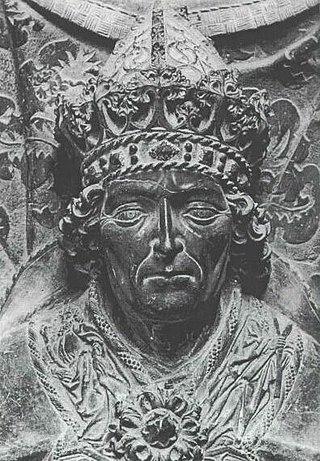
Louis IV, called the Bavarian, was King of the Romans from 1314, King of Italy from 1327, and Holy Roman Emperor from 1328 until his death in 1347.

Charles IV, also known as Charles of Luxembourg, born Wenceslaus, was Holy Roman Emperor from 1355 until his death in 1378. He was elected King of Germany in 1346 and became King of Bohemia that same year. He was a member of the House of Luxembourg from his father's side and the Bohemian House of Přemyslid from his mother's side; he emphasized the latter due to his lifelong affinity for the Bohemian side of his inheritance, and also because his direct ancestors in the Přemyslid line included two saints.

Conrad, a member of the Hohenstaufen dynasty, was the only son of Emperor Frederick II from his second marriage with Queen Isabella II of Jerusalem. He inherited the title of King of Jerusalem upon the death of his mother in childbed. Appointed Duke of Swabia in 1235, his father had him elected King of Germany and crowned King of Italy in 1237. After the emperor was deposed and died in 1250, he ruled as King of Sicily until his death.
A count palatine, also count of the palace or palsgrave, was originally an official attached to a royal or imperial palace or household and later a nobleman of a rank above that of an ordinary count. The title originated in the Late Roman Empire. In the Middle Ages especially and into modern times, it is associated with the Holy Roman Empire, especially Electoral Palatinate.

Günther XXI von Schwarzburg, disputed King of Germany, was a descendant of the counts of Schwarzburg.

Henry (VII) (1211 – 12 February 1242), a member of the Hohenstaufen dynasty, was King of Sicily from 1212 until 1217 and King of Germany (formally Rex Romanorum) from 1222 until 1235, as son and king, co-ruler of Emperor Frederick II. He was the seventh Henry to rule Germany, but in order to avoid confusion with the Luxembourg emperor Henry VII, he is usually numbered Henry (VII).

The House of Luxembourg or Luxembourg dynasty was a royal family of the Holy Roman Empire in the Late Middle Ages, whose members between 1308 and 1437 ruled as kings of Germany and Holy Roman emperors as well as kings of Bohemia, Hungary and Croatia. Their rule was twice interrupted by the rival House of Wittelsbach. The family takes its name from its ancestral county of Luxembourg which they continued to hold.

The House of Schwarzburg was one of the oldest noble families of Thuringia, which is in modern-day central Germany. Upon the death of Prince Friedrich Günther in 1971, a claim to the headship of the house passed under Semi-Salic primogeniture to his elder sister, Princess Marie Antoinette of Schwarzburg who married Friedrich Magnus V, Count of Solms-Wildenfels. Reigning over the County of Schwarzburg and founded by Sizzo I of Schwarzburg, the family split in the 16th century into the lines of Schwarzburg-Sondershausen and Schwarzburg-Rudolstadt, with the Sondershausen line dying out in 1909.

Rudolf I of Bavaria, called "the Stammerer", a member of the Wittelsbach dynasty, was Duke of Upper Bavaria and Count Palatine of the Rhine from 1294 until 1317.

Louis V, called the Brandenburger, a member of the House of Wittelsbach, ruled as Margrave of Brandenburg from 1323 to 1351 and as Duke of Bavaria from 1347 until his death. From 1342 he also was co-ruling Count of Tyrol by his marriage with the Meinhardiner countess Margaret.

Frederick IV was Burgrave of Nuremberg from 1300, until his death in 1332. He was the younger son of Burgrave Frederick III from his second marriage with the Ascanian princess Helene of Saxony.
Ludwig of Bavaria or Louis of Bavaria may refer to:

Adolph I of Cleves was the second Count of Cleves and the fourth Count of Mark.
Henry VIII was King of England from 1509 to his death in 1547.

Frederick, a member of the House of Welf, was Duke of Brunswick-Lüneburg and ruling Prince of Brunswick-Wolfenbüttel from 1373 until his death. In May 1400, he unsuccessfully stood as a candidate for the election as German king-elect at Frankfurt, in opposition to Wenceslaus of Luxembourg, and was murdered on his way home.
Otto III, Holy Roman Emperor (980–1002) was Holy Roman Emperor from 996 until his death.

Beatrice of Silesia was a Polish princess member of the House of Piast in the Silesian branch of Jawor-Świdnica and by marriage Duchess of Bavaria and German Queen.
Count Günther VII of Schwarzburg was Count of Schwarzburg-Blankenburg from 1236 until his death.
This page is based on this
Wikipedia article Text is available under the
CC BY-SA 4.0 license; additional terms may apply.
Images, videos and audio are available under their respective licenses.











